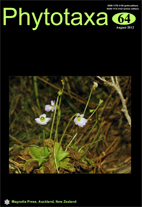Abstract
As a consequence of molecular phylogenetic studies, the monotypic genus Primulina has recently been recircumscribed and expanded to include Chirita sect. Gibbosaccus, Chiritopsis, and Wentsaiboea. Based on phylogenetic analyses of ITS sequences and apparent morphological similarity, we make further transfers of six species of Chirita (C. leprosa, C. lijiangensis, C. ningmingensis, C. luochengensis, C. rongshuiensis, and C. tiandengensis) and four of Chiritopsis (Ch. danxiaensis, Ch. hezhouensis, Ch. jingxiensis, and Ch. longzhouensis) that were neglected or published around or slightly after these recent taxonomic treatments. The proposed nomenclatural changes include one new name, P. pseudolinearifolia, and nine new combinations, P. danxiaensis, P. hezhouensis, P. jingxiensis, P. leprosa, P. lijiangensis, P. longzhouensis, P. ningmingensis, P. rongshuiensis, and P. tiandengensis. The addition of these ten species increases the number of the genus to ca. 150 species, making Primulina one of the largest and morphologically most diverse genera of the Old World Gesneriaceae.

